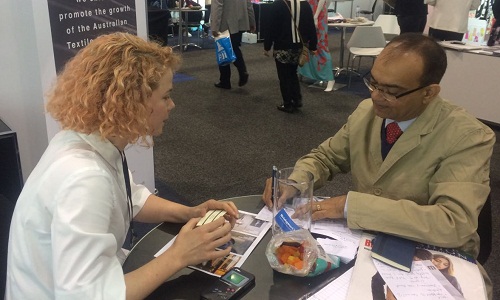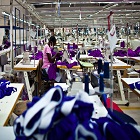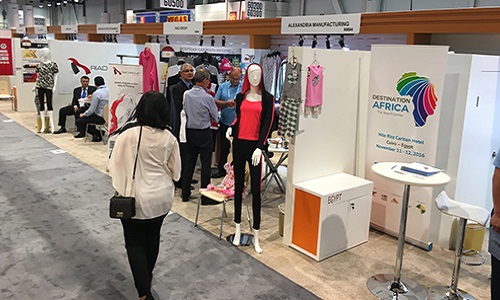FW
"One of the features of this edition of ISEA has been the support of the Council of Textile & Fashion. This is an industry body which exists to promote the growth of the industry in Australia. It helps members strengthen their local and off-shore supply chains."

One of the features of this edition of ISEA has been the support of the Council of Textile & Fashion. This is an industry body which exists to promote the growth of the industry in Australia. It helps members strengthen their local and off-shore supply chains.
It's a not for profit organisation with 65 years of service to the industry, and members are drawn from across the fashion and textile industry.

Its focus areas are growing exports, navigating start ups, harnessing innovation, helping supply chains get globalised in order to optimize and supporting ethical practices. It supports and guides local industry to help grow their business.
Key supporting activities are training networks, organizing workshops and seminars, tailored and accredited training.
Among its other initiatives are setting industry policy and showcasing emerging designers. It gives an immense opportunity to young budding designers to showcase in this very progressive nternational show.
It connects with international industry and potential collaborators and adds a lot of academic value to the event. The council conducted three academic sessions in the seminar section in the following order. One was conducted on the first day of the show and the remaining two were lined up for the last day.
"The Council of Leather Exports has participated for the first time in ISEA with 18 booths. It came to ISEA with the objective of creating both forward and backward linkages. It has got forward linkages through visitors from Australia and New Zealand. As for backward linkage it has initiated discussions for sourcing very high quality cow skin. Going forward it has plans to take a delegation to Australia to take this opportunity to its logical conclusion."

The Council of Leather Exports has participated for the first time in ISEA with 18 booths. It came to ISEA with the objective of creating both forward and backward linkages. It has got forward linkages through visitors from Australia and New Zealand. As for backward linkage it has initiated discussions for sourcing very high quality cow skin. Going forward it has plans to take a delegation to Australia to take this opportunity to its logical conclusion.
The current scenario is that India exports roughly 70 per cent to the EU and 10 per cent to the US. Opportunities are being explored in Latin American countries.
Since India’s quality standards are moving up, the country is expecting to taking over some share from Chinese suppliers.
The leather industry is broadly a labor intensive sector and presently the council is scaling up, improving notably in its designing capability.
The Council of Leather Exports participates in fairs in Japan, Italy, Las Vegas, Turkey, Germany, Russia, China, Hong Kong.
The Indian leather industry accounts for around 12.9 per cent of the world’s leather production of hides/skins. The country ranks second in terms of footwear and leather garment production in the world. India’s leather industry has grown drastically, transforming from a mere raw material supplier to a value-added product exporter.
"Looking for promising growth havens, companies are exploring newer markets having immense potential. One of the emerging markets is Africa. Big brands are investing and those that have already invested are looking at expanding. At the first edition of the Destination Africa sourcing show held recently in Cairo, 85 exhibitors from around the continent got together to display their products and offerings with major brands from the US and Europe."

Looking for promising growth havens, companies are exploring newer markets having immense potential. One of the emerging markets is Africa. Big brands are investing and those that have already invested are looking at expanding. At the first edition of the Destination Africa sourcing show held recently in Cairo, 85 exhibitors from around the continent got together to display their products and offerings with major brands from the US and Europe.
Dina Abdel Aziz, project director for Destination Africa points out when they thought about ‘Destination Africa’, the aim was to attract the attention of buyers of Africa as a region, not only Egypt. Especially now that prices are increasing in China, an awareness needs to be crated among buyers on emerging regions in Africa.
Egypt, the new frontier
Egypt doesn’t benefit from duty free access to the US market under the Africa Growth and Opportunity Act (AGOA) but it does enjoy the same duty free trade privileges under the Qualifying Industrial Zone (QIZ) programme. Alex Apparels, the manufacturing arm of Alpine Creations in Egypt, has been making product for Walmart for 22 years and the retailer is confident in the company’s abilities, it taps into its design and technology expertise to guide the product it puts in its stores.
Walmart makes up half of Alex Apparel’s customer base, but the company also supplies to Under Armour, Hanes and Carters/Oshkosh, with 80 per cent of its business in knits and the other 20 per cent in wovens. The products are manufactured in five factories in the Alexandria City region of Egypt. The company has also started building its own mill in Egypt to be less reliant on fabric sourcing from Asia, and is aiming for eventual vertical integration. This will eventually shorten supply time and increase flexibility.
Kenya, an upcoming destination
When one is looking at Africa, Kenya comes into immediate limelight. The country is primed for taking on more manufacturing—not to mention its duty-free benefits under AGOA. Stability and guaranteed quality are among the two main aspects that are offering growth avenues towards Kenya. There is an easy availability of manpower and training the manpower is equally easy. The country’s ranking of ease of doing business has been improving steadily since the past few years. The minimum wage for workers in Kenya is roughly $100 per month, and though it’s a little higher than some of its neighbouring nations, manufacturers there are not in the business of giving buyers goods that are low quality and over-priced.
Lesotho, a promising destination
Lesotho is another other promising countries to do business with as it enjoys access to the US and EU markets duty free, a reasonably low cost of doing business and the potential to fulfill demands of customers. The manufacturing sector is the second biggest employer after the government, according to Puseletso Makhakhe, investment services manager for the Lesotho National Development Corporation (LNDC). The country has stable political and social environment. No labour unrest has been reported so far by companies operating out of Lesotho. The current minimum wage for unskilled workers is around $80 a month, and for skilled workers, the rate jumps to $100 a month.
Suddenly sea waste has become valuable as apparel companies are using it to create new products. Adidas for example, is selling shoes made mostly of plastic collected off the coast of the Maldives. A swimsuit line from Volcom is largely made from recycled nylon materials, including abandoned fishing nets.
Sportswear companies are putting ocean trash back to work – recovering, recycling, and repurposing materials for use in shoes, jerseys, and swimsuits. The ultimate ambition is to eliminate virgin plastic from their supply chain. Water bottles, grocery bags, and nylon fishing nets persist far longer than we can use them, and when they’re not properly recycled, they can end up killing marine life.
About 12 million tons of plastic trash end up in the world’s oceans every year. The up cycling-plastic practice is about taking action and implementing strategies that can end the cycle of plastic pollution for good. So the fact that Volcom’s swimsuits are made with recovered fishing nets creates a natural connection to surf culture, which fully understands the value of keeping the ocean clean.
Some 6,40,000 tons of fishing gear are lost or abandoned each year, leading to the deaths of an untold number of fish, sharks, sea turtles, dolphins, and other wildlife. One apparel company is recycling ten million pounds of fishing nets annually, mainly to make yarn for carpets.
Spanish brand Zara is leading the fashion industry in its home country. In terms of unique customers, Zara is the absolute leader in Spain. During July, the Spanish retailer welcomed over 2, 53,000 customers, while the number two on the list, Asos, stays behind with 1,05,000 buyers. Zalando and Pull & Bear are other popular online fashion destinations for Spanish consumers.
Zara is the flagship brand of the Inditex Group. Zara also has the best conversion rate in the Spanish online fashion sector. Its conversion rate is 12 per cent, which is more than its competitors Asos (nine per cent) or Massimo Dutti (nine per cent). Zalando, the biggest online fashion retailer in Europe, welcomed more unique visitors in July than Zara, but ended with a conversion rate of three per cent.
In Spain, more than half a million people shopped fashion online during the month of July this year. An average order of clothing and accessories was worth 57 euros. Especially, Zara was a popular shopping destination, followed by Asos and Zalando.
A majority (56 per cent) of online fashion shoppers in Spain is female, while the share of women is even higher (69 per cent) when we look at the amount of money spent on fashion online.
Textiles manufacturer and exporter Welspun’s net sales grew 19 per cent in the September quarter. It posted a net loss of Rs 147.52 crores. Welspun’s total income from operations jumped 22 per cent in July to September 2016 from the same quarter last year. The company achieved its highest quarterly top line during the quarter.
The company has taken a one-time hit of Rs 501 crores with regard to the traceability issue in Egyptian cotton. Despite a 18.2 per cent revenue growth in the first half of 2016-17, Welspun forecast flat revenue for the full financial year. It plans to become a zero debt company by 2020 by shedding its Rs 2,500 crores debt.
Welspun plans to expand its focus on branded and innovative products to become a two billion dollar company in four years, with 20 per cent revenue coming in from domestic sales. It will set up a Rs 600 crores carpet plant near Anjar in 18 months. The investment will be met through internal accruals and debt. The company also plans to spend Rs 600 crores over 18 months spread over financial year 2018 and 2019 to make carpets and rugs. The company’s credit ratings have also been reaffirmed.
Ahmedabad-based Nandan Denim’s net profit rose 4.42 per cent for the second quarter of 2016-17. The company is poised to be Asia’s largest denim fabric manufacturer. Net sales for the second quarter were higher by 2.75 per cent. EBITDA and PAT margins were 16.23 per cent and 5.38 per cent. EPS stood at Rs 3.39 at a face value of Rs 10 per share.
For the six months ended September 2016, the company’s net profit rose 3.73 per cent. Net sales in the first half of 2016-17 were higher by 4.88 per cent compared to the first half of the previous fiscal. For the first half of 2016-17, EBITDA margin stood at 16.21 per cent and PAT margin at 5.35 per cent.
Nandan, opened in 2004 has a capacity for 120 million meters a year. It makes products from three ounce to 15 ounce. It has backward integration of spinning and fancy attachments. It has economies of scope and scale. It gets value addition from fabrics. Its response time is fast.
Nandan wants to shift from being a denim manufacturer to a fashion driven brand. It wants growth with value. The group turnover last year was two and a half thousand crores and Nandan’s share was Rs 1200 crores.
Orders for Italian textile machinery recorded an increase of 16 per cent for the third quarter of 2016. The third quarter value for 2016 stood at 101.1 points. However, this growth applied to exports only, where the index recorded an absolute value of 112.3 points, a 20 per cent increase compared to July to September 2015. In Italy, the index stood at 48 points, dropping by 14 per cent over the same quarter in 2015.
The situation in Italy’s domestic market appears to be less positive. The order intake has declined after two consecutive quarters of growth. Italian textile machinery manufacturers comprise around 300 manufacturers, employing close to 12,000 people and producing machinery for an overall value of about euro 2.6 billion, with exports amounting to 86 per cent of total sales.
It is confident that the plan put forward by the Italian government for 2017 fiscal year can give confidence to businesses which need to invest. Italy is the world’s second largest producer of machinery for the textiles industry. In the production of machinery for tanning, and for the footwear and leather goods industry, Italy accounts for over 50 per cent of world production.
Italian manufacturers have for a while now focused on the sustainability of their products to meet a demand for technological solutions that effectively lower consumption and, as a consequence, production costs.
Indo Rama Synthetics’, India’s largest dedicated polyester manufacturer saw its sales volume rise 16.13 per cent for the quarter ended on September 30, 2016. But it reported a net loss of Rs 14.69 crores for the quarter that ended on September 30, 2016, compared to a net loss of Rs 49.71 crores in the corresponding quarter of last year.
Operational EBIDTA for the quarter was Rs 3.47 crores, compared to Rs 0.60 crores in the corresponding quarter of last year. The company reported operational revenue of Rs 766.16 crores during the quarter, compared to Rs 695.03 crores for the same period of the previous year.
The main business activities are textiles, polyesters, and industrial chemicals. However in the last few years there has been an oversupply of polyester in the industry. This has resulted in lower profit margins for the company. Indo Rama has taken several initiatives to improve its operational performance in terms of specialty products, higher capacity utilisation, cost control initiatives and addition of new customers. The production capacity is 6,10,050 tons per annum of polyester staple fiber, filament yarn, draw texturized yarn, fully drawn yarn and textile grade chips. Besides India Indo Rama has a strong presence in Indonesia, Thailand, USA, Nepal and Sri Lanka.
"In the highly competitive landscape transforming an unsustainable global supply chain is extremely challenging. But this can be achieved if competitors become colleagues and mentors to garner progress in the long run. It’s the power of collective action that can transform the entire textile and apparel landscape. The same phenomenon was witnessed recently in New York City as environmental nonprofit Canopy, along with H&M, Zara, Stella McCartney, Marks & Spencer and Eileen Fisher, came together along with 87 global fashion brands and retailers to strategies conservation solutions for the world’s endangered forests."

In the highly competitive landscape transforming an unsustainable global supply chain is extremely challenging. But this can be achieved if competitors become colleagues and mentors to garner progress in the long run. It’s the power of collective action that can transform the entire textile and apparel landscape. The same phenomenon was witnessed recently in New York City as environmental nonprofit Canopy, along with H&M, Zara, Stella McCartney, Marks & Spencer and Eileen Fisher, came together along with 87 global fashion brands and retailers to strategies conservation solutions for the world’s endangered forests.
Connecting the dots

The immensely popular fabric rayon (otherwise known as viscose, modal or lyocell) has become a major driver of logging globally, with more than 120 million trees disappearing into the fabric annually. According to Giles Bolton, Responsible Sourcing Director, Tesco, going by consumers’ demand for eco-friendly clothing in the most affordable range, we need to save on forests and preserve natural wealth. For this to happen, companies must come forward to create a shift in the global fiber supply and ensure it becomes free of ancient forests. With a shared 2017 deadline to end the use of endangered forests in fabrics fast approaching, the campaign has gained strong momentum.
Here are five key reflections from the summit on companies’ collective efforts:
Success linked to being together
The power of collaboration is shifting the rayon supply chain at almost record pace. Three years since its launch, CanopyStyle has 68 apparel brands and designers committed towards eliminating use of fabrics containing endangered forests. This phenomenon has forced producers, representing 70 per cent of global rayon production, to work with Canopy, and kick-start innovative solutions as well as build lasting conservation solutions for forests. As an NGO, Canopy is conscious of the business adage ‘the customer is always right’.
Setting a stronger foundation
Every movement starts with a spark. And in this movement, the CanopyStyle Leaders’ Working Group has set the fire of this industry-wide shift ablaze. H&M, Stella McCartney, EILEEN FISHER, Marks & Spencer and Inditex/Zara already work closely with Canopy on strategic planning, implementing ideas, influencing forest conservation on the ground and setting the pace for the sector. With the support of this cadre of brands, Canopy has been able to catch the attention of viscose producers and motivate them to embark upon a path of similarly ambitious environmental commitments.
Creating awareness of the unknown

Connecting the complex rayon supply chain to a specific place and community, enables brand representatives to analyses as to how big the price tag associated with sourcing can be and how well positioned they are to help advance change on the ground. In this regard, Boreal is one of the most important, intact forests remaining on the planet, which plays a vital role in mitigating climate change, provides copious fresh water and acts as the nursery for billions of birds every year. The Boreal is also a landscape where there is going to be a significant increase in logging for rayon production over the coming decade.
Projecting the data
Canopy has developed systems and tools to support brand representatives. One such tool was The Hot Button Issue (PDF), a report ranking the world’s largest viscose producers. This detailed report helps brands to make the most informed decision about where to source rayon as well as track rayon producers’ progress. Feedback from the Summit will also help Canopy in developing the next generation of tools and it became clear that public profile and communications about the issue and initiative will become a priority in 2017 and beyond.
Building markets for GenX fabrics
Building markets for next gen fabrics that support global economy and advancing conservation legacies in priority forest landscapes are key elements of Canopy’s work with the fashion sector. While brands focus on reversing the adverse impacts of their viscose supply chain, they also contribute to conservation legacies in Landscapes of Hope such as the Great Bear Rainforest and systemic solutions that will see textiles produced from waste fabrics.
Additionally, fun and quirky awareness campaigns such as Stella McCartney’s deforestation videos engage people on serious issues. Envisioning the ‘Art of the Possible’ and having fun with it is key to ensure that the movement continues to build and that ultimately, ultimately being stylish doesn’t have to harm the earth.













